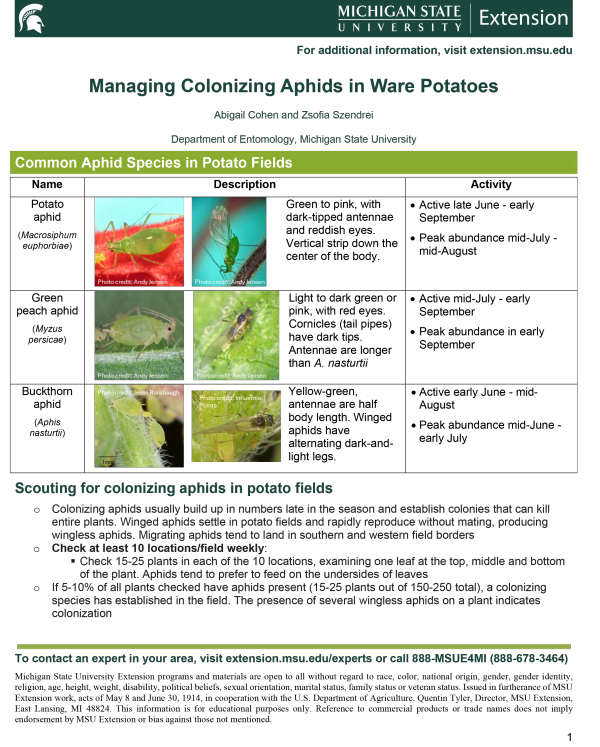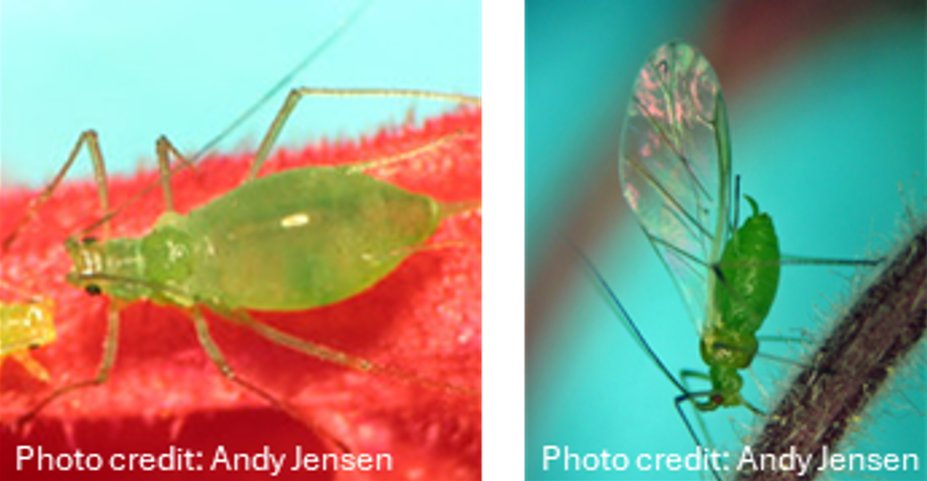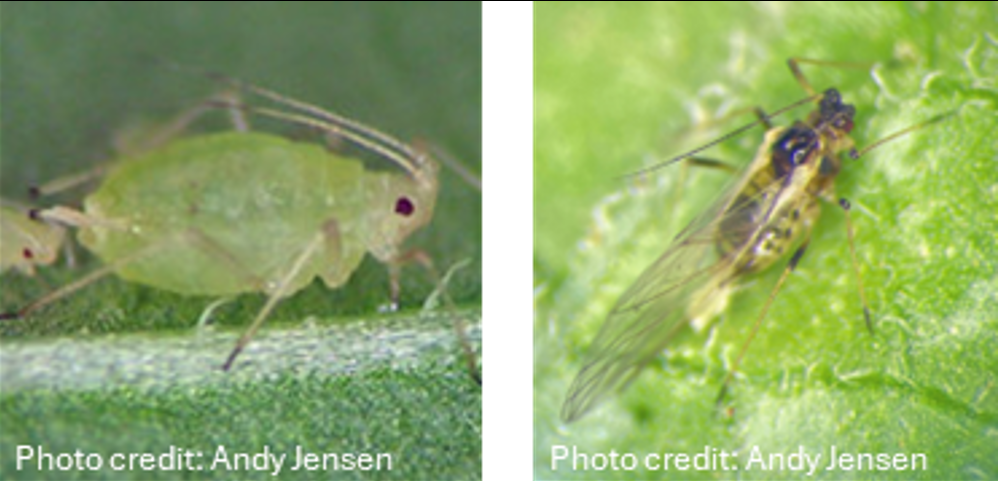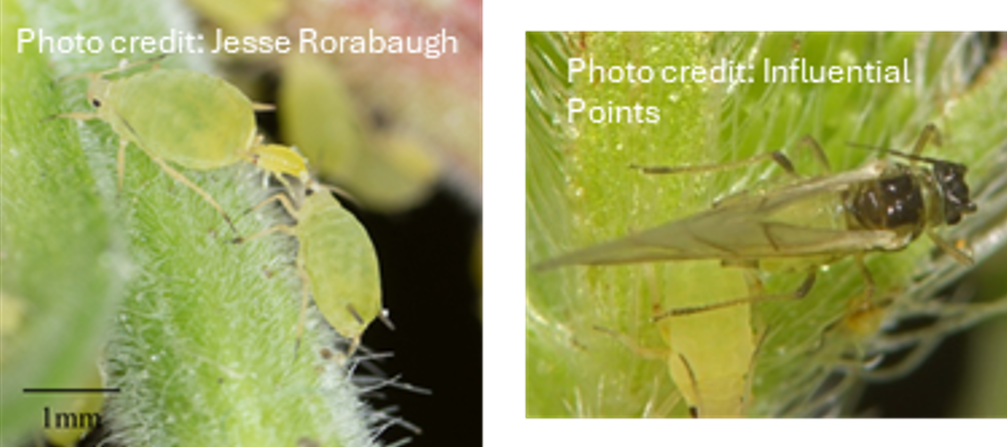
Managing Colonizing Aphids in Ware Potatoes
DOWNLOADJune 20, 2025 - Abigail Cohen and Zsofia Szendrei, Department of Entomology, Michigan State University
Common Aphid Species in Potato Fields
| Name | Description | Activity |
|---|---|---|
| Potato aphid (Macrosiphum euphorbiae) |  Green to pink, with dark-tipped antennae and reddish eyes. Vertical strip down the center of the body. Green to pink, with dark-tipped antennae and reddish eyes. Vertical strip down the center of the body. |
• Active late June - early September • Peak abundance mid-July - mid-August |
| Green peach aphid (Myzus persicae) |
 Light to dark green or pink, with red eyes. Cornicles (tail pipes) have dark tips. Antennae are longer than A. nasturtii Light to dark green or pink, with red eyes. Cornicles (tail pipes) have dark tips. Antennae are longer than A. nasturtii |
• Active mid-July - early September • Peak abundance in early September |
| Buckthorn aphid (Aphis nasturtii) |
 Yellow-green, antennae are half body length. Winged aphids have alternating dark-and-light legs. Yellow-green, antennae are half body length. Winged aphids have alternating dark-and-light legs. |
• Active early June - mid-August • Peak abundance mid-June - early July |
Scouting for colonizing aphids in potato fields
- Colonizing aphids usually build up in numbers late in the season and establish colonies that can kill entire plants. Winged aphids settle in potato fields and rapidly reproduce without mating, producing wingless aphids. Migrating aphids tend to land in southern and western field borders
- Check at least 10 locations/field weekly:
- Check 15-25 plants in each of the 10 locations, examining one leaf at the top, middle and bottom of the plant. Aphids tend to prefer to feed on the undersides of leaves
- If 5-10% of all plants checked have aphids present (15-25 plants out of 150-250 total), a colonizing species has established in the field. The presence of several wingless aphids on a plant indicates colonization
Chemical control for colonizing aphids
- Do not apply any Mode of Action (MOA) more than twice consecutively before switching to a new group.
- Do not use any group 4 MOA more than once a season, and if using two groups within group 4, do not use them consecutively.
- Groups 1A, 1B, and 3 are not recommended because of resistance and potential harm to natural enemies.
- If a neonicotinoid was applied at planting, do not use other foliar 4A product. If applied at planting, expect 60-90 days of residual control.
- Using insecticides that are selective to aphids helps to preserve beneficial insects in the field.
Recommended “Modes of Action” after at-planting neonicotinoid application
|
Mode of Action Group |
Sub-group/ chemical name |
Trade name |
Use and efficacy |
Selectively kills aphids* |
|---|---|---|---|---|
|
4C
|
sulfloxaflor
|
|
Apply before the at-planting systemic wears out and when aphid populations are still low. Don’t use consecutively after a group 4 application, only after another MOA. |
Yes |
|
4D |
flupyradifurone |
Apply before the at-planting systemic wears out and when aphid populations are still low. Don’t use consecutively after a group 4 application, only after another MOA. |
Yes |
|
|
9B
|
pymetrozine
pyrifluquinazon |
|
Apply before the at-planting systemic wears out and when aphid populations are still low. Paralyzes mouthparts. Aphids remain on plant until they desiccate. |
Yes |
|
9D |
afidopyropen |
Apply at first aphid detection, reduces aphid feeding. |
Yes |
|
|
21A |
tolfenpyrad |
Control requires contact with aphids, has rapid anti-feeding effect. |
No |
|
|
23 |
spirotetramat |
Apply before the at-planting systemic wears out and when aphid populations are still low. |
Yes |
|
|
28 |
cyantaniliprole |
Apply before aphid populations build up, has rapid anti-feeding activity. Works best when combined with adjuvant. |
No |
|
|
29 |
flonicamid |
|
Apply before aphid populations build up. Paralyzes mouthparts. Aphids remain on plant until they are desiccated. Recommended threshold is 5 wingless aphids/100 leaves or one winged aphid/plant. |
Yes |
|
Not Classified |
Mineral / Paraffin oil or Petroleum distillate |
Many products available |
Interferes with respiration and metabolism, disrupts feeding. May have phytotoxic effects under high temperatures (>95 F) or if plant is stressed. |
Yes |
*Insecticides that selectively kill aphids can also sometimes kill other insects with piercing-sucking mouthparts, such as leafhoppers, but check the label if your goal is to control multiple pests at the same time.



 Print
Print Email
Email





